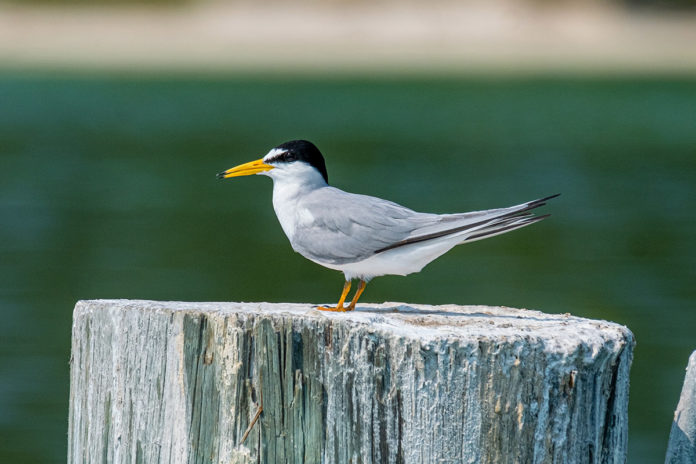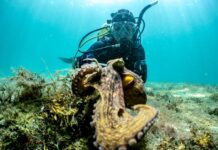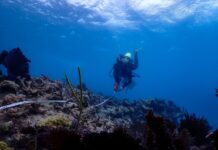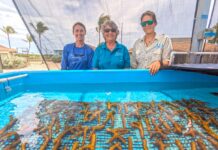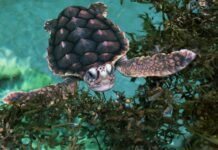Least terns never seem substantial enough to exist in the real world. The rational part of my brain knows they’re made of flesh and blood and feathers like all birds, but the evidence-resistant part of my brain is still convinced they are made out of styrofoam, or a more magical, less environmentally damaging version of it. There is just such a lightness to them.
It’s the way they fly — each wingbeat pulling them higher than you think it should. When they feed, they fall from 20 or 30 feet up and hit the water in a controlled crash, but hardly break the surface. They almost always rise back up with some small, shiny fish in their bill.
You see other plunge-diving birds in these parts — sandwich terns, roseate terns, osprey — all of which seem the embodiments of grace and precision, until you compare them to least terns. Then they are suddenly the uninvited oafs doing unwanted cannonballs at a pool party.
Terns are the classier cousins of gulls, sleeker and faster, with wings that tend to be pointed and tails that tend to be forked. They don’t dumpster-dive or steal French fries from unsuspecting seaside diners the way gulls do. They keep it clean. Most tern species live near the water and survive almost exclusively on fish.
There are 47 species of terns in the world, and the least terns are, in fact, the least of them, at least in terms of physical stature. They’re the smallest and the lightest. Nine inches from tip of the bill to the tip of the tail with a 20-inch wingspan, they weigh in at 1.75 ounces, which is nine tenths the weight of a tennis ball.
With other small birds – say, warblers, tanagers or sandpipers – you tend to go Stuart Little when you watch them and mentally scale the world down, especially when you watch them through binoculars. A birdbath becomes a swimming pool, a banyan tree a mega mansion.
That doesn’t happen with least terns. They always seem like tiny sprites in an outsized landscape, either totally at rest, or hyperkinetically zipping through the air.
If you live in the Keys you’ve seen least terns, even if you don’t know it. You have definitely heard them.
Throughout most of their eons-long history, least terns nested on beaches, digging out shallow divots or scrapes in which to lay their eggs. Their chicks are precocial, meaning they can walk as soon as they hatch, and the tiny brown powder puffs with legs tend to cluster in whatever shade they can find. Like small drifts of dirty snow, they mostly stay invisible to predators.
Like so many Florida bird species, least tern populations were first decimated in the late 19th and early 20th centuries by the plume hunters, who gunned them down to sell their feathers to the hat-making trade (though you have to wonder how many least tern feathers would survive a shotgun blast). As their populations slowly began to recover, Florida coastal areas began to get developed, and functional beach habitat began to disappear.
To adapt to their habitat loss, they began nesting on gravel rooftops – the kind you find in large shopping centers or on government buildings. About a third of the North American least tern population — about 7,000 pairs — breeds in Florida. An estimated 55% of those now nest on rooftops.
In Key West they’re on top of the Winn Dixie, the K-Mart, both Publixes, the Professional Building on 12th Street, the federal courthouse on Simonton Street, and a number of Navy properties. Stop in any of those parking lots — or the parking lot of pretty much any large grocery store in the Keys — between April and August and one will most likely fly over before you’ve managed to lock your car door. Just listen for the raspy/tinny ta-KEE ta-KEE ta-KEE call and look for the undersized, fluttering white streak.
While it’s great to see such a deft adaptation to the modern landscape, it’s probably not a long-term solution, as gravel roofs are becoming outmoded in contemporary building practices, and they will slowly begin to disappear.
When you hear of situations like the one at the Futura Yacht Club in Tavernier a few months ago, where a contractor gathered up an entire colony’s worth of chicks, put them in a box, and took them to the Florida Keys Wild Bird Rehabilitation Center, things can get a little depressing. After resistance from the president of the homeowners association, the birds were eventually returned to the roof, but it took so long it is unlikely any of them survived.
Because Florida’s wildlife protection laws are so toothless, as restitution, Futura Yacht Club was forced to give a whopping $1,000 donation to Audubon Florida, which Audubon Florida refused to accept, calling it “blood money.” Basically, anyone who wants to wipe out an entire colony of birds can consider it the cost of doing business and do it on the cheap. (You can find more information about this incident at markhedden.com/notes.)
In a heartening contrast to the Tavernier incident, in recent weeks a group of least terns decided to nest on the ground in the corner of the lot of the Police Athletic League building that is being renovated at Truman Waterfront Park. That area has now been temporarily fenced off so the least terns can raise their chicks in peace. Apparently they’ve even brought some PVC pipes in, so the terns can have a little shade.















